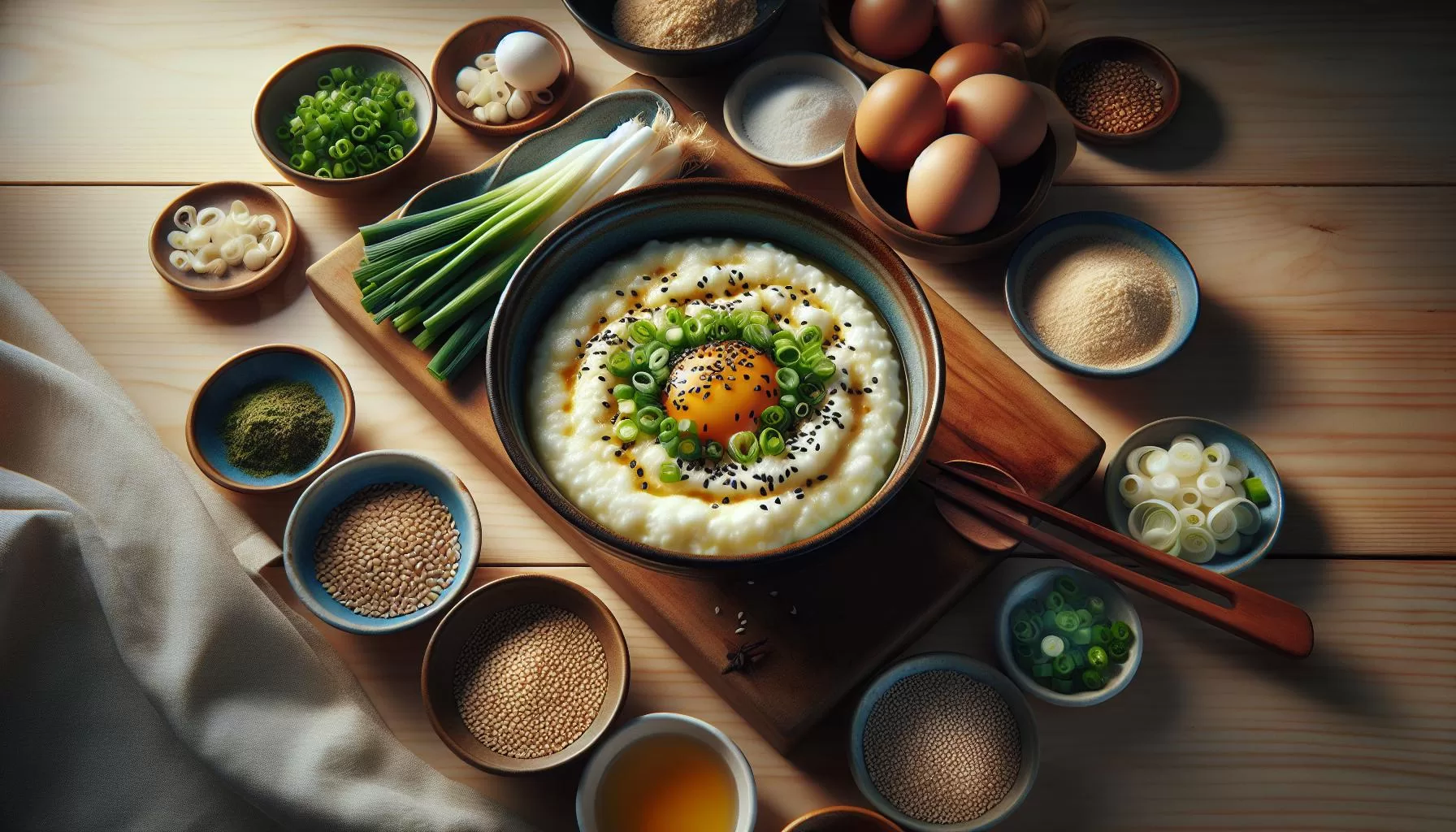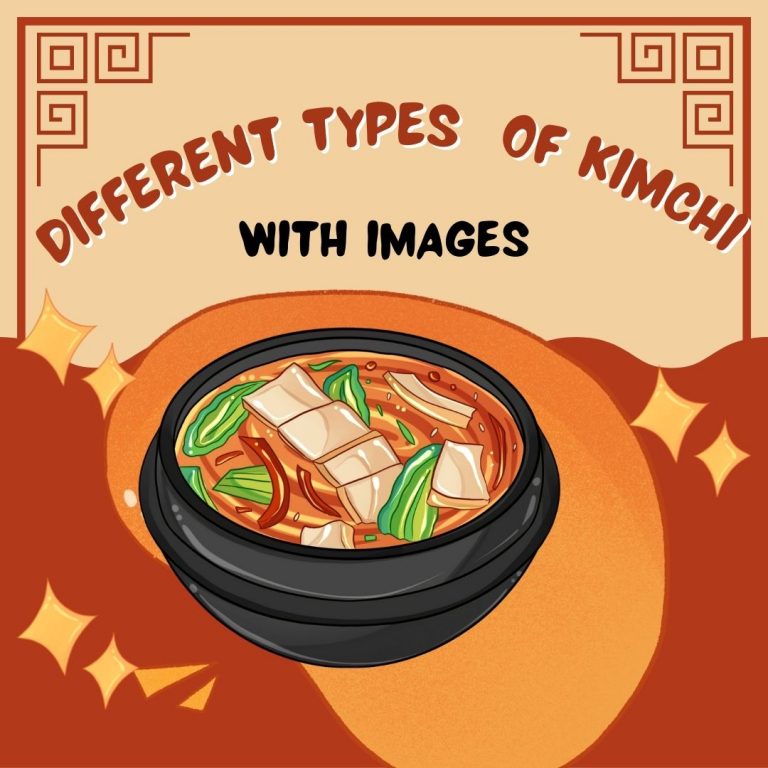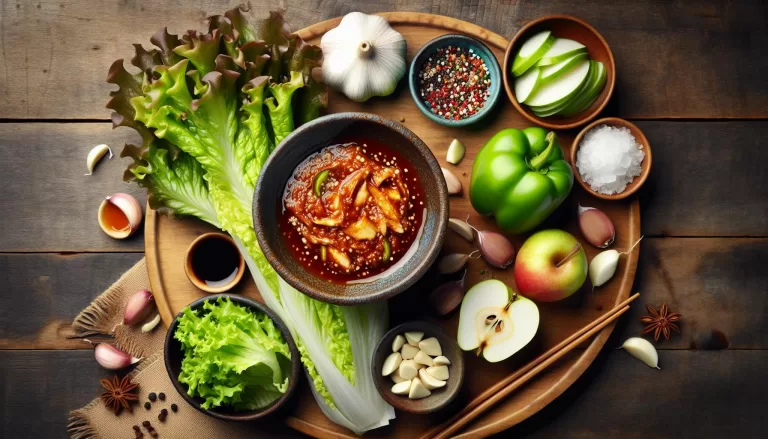Easy & Affordable Homemade Korean Steamed Egg Gyeranjjim Recipe – Health Benefits & Nutritional Facts

Ingredients for Homemade Korean Steamed Egg Gyeranjjim
A great meal starts with quality ingredients. To make the perfect homemade Korean steamed egg dish, here’s what you’ll need:
- 3 Eggs: The main ingredient, standard size eggs are perfect.
- 1 cup of Broth: Chicken or vegetable broth add a depth of flavor. You can also use water, but broth is preferred.
- 1 Green Onion: This is for garnishing and also adds flavor to the dish. Chop it finely.
- 1 tsp of Salt: Adjust to your taste. Remember, you can always add more but you can’t take it out!
- 1 tsp of Sesame Oil: Gives the dish a unique, nutty flavor.
If you’re looking to add a special twist to your Gyeranjjim, consider adding diced ham or shellfish. It’s not traditional, but these ingredients can add a whole new dimension of flavor.
Let’s look at the nutritional information for our classic homemade Korean steamed egg Gyeranjjim.
| Component | Amount |
|---|---|
| Calories | 226 |
| Carbs | 3g |
| Protein | 11g |
| Fat | 18g |
Keep in mind, nutritional values can vary based on the specific ingredients used. The values provided are an estimate.
Alright, you’ve got your ingredients all set. Next, we move onto the fun part – cooking.
Stay tuned for a step-by-step guide on how to prepare your homemade Korean steamed egg dish, Gyeranjjim.
Step-by-Step Instructions

Let’s move on to the crux of the matter: mastering the cooking process. Pull out your whisk, gather your ingredients and put your chef’s hat on because it’s time to start cooking!
1. In a Bowl, Beat the Eggs
Begin by cracking open your three eggs into a medium-sized bowl. Then whisk them well. You’re targeting a complete blend, resulting in a mixture where the yolk is fully combined with the egg whites.
2. Mix in the Broth
Next, embrace subtlety – pour in one cup of chicken or vegetable broth. For a twist, replace part of the broth with soy milk. It’ll give your eggs a velvety texture.
3. Season the Mixture
In this step, less is more. Add in just a half teaspoon of salt. Remember, you can always add but you can’t subtract. For an umami boost, consider a dash of fish sauce; Just be cautious, as it’s potent stuff.
4. Prep the Add-Ins
Chop one green onion fine, cube some ham or shellfish, add them to the egg mix. The more colorful, the better. The beauty of this dish is that you can customize it to your own liking; feel free to experiment with mushrooms, red bell peppers, or even cheese.
5. Steam it Up
Pour the entire mix into a heat-proof bowl or traditional Korean ttukbaegi. Use your steamer to cook the dish on medium heat for about 20 minutes. For a richer flavor, use a pressure cooker instead and cut the cooking time down to 10 minutes.
6. Garnish and Serve
Once the egg is firm, bring it out of the heat. Garnish with a drizzle of sesame oil and a sprinkle of toasted sesame seeds. Cast that finishing touch by dusting top with some more chopped green onions.
With this detailed guide, you’re sure to be an expert in making homemade Korean steamed egg Gyeranjjim in no time! Let your culinary creativity take the lead and enjoy this Korean delicacy that is not just visually enticing but also a healthy treat. Don’t forget to take a snapshot of your masterpiece, you’ll want to show it off!
Dive into your cooking adventure and remember – the joy is in the journey, not just the destination.
Tips for Making the Perfect Steamed Egg Gyeranjjim

First and foremost, the freshness of your eggs is key to achieving a tender, custard-like texture. The fresher the egg, the smoother your result will be.
Where you might falter is picking up that carton of eggs without giving it a second thought. Don’t let dated eggs put a damper on your Korean culinary journey. You’ll do well to check the manufacturing date on the box.
Consider your utensils as well. A heat-resistant bowl makes a world of difference. It assures that your mixture cooks evenly, preventing unappetizing lumps. On the topic of mixing, whisk thoroughly. You are aiming for a uniform blend. Any stray yolk or egg white can cause unsightly discolorations in your beautiful dish.
Next, factor in your liquid of choice. Options abound. Chicken, beef, or vegetable broth, you decide what aligns with your taste buds. The quality of your broth directly affects the flavor of your steamed egg Gyeranjjim. Therefore, always opt for a homemade or high-quality commercial broth.
Customization is encouraged. Simple add-ins, like green onions and ham, are classic. Yet, don’t hesitate to step out of the mold and be creative. Unconventional options like mushrooms and bell peppers add a surprising twist to the dish’s overall flavor.
Pressure cooking shortens your waiting period, but traditional stovetop steaming also works well. Monitor your heat, though. High temperatures can disrupt the smooth texture you are aiming for. So, with either method, a low and slow approach is recommended.
On to the garnish. A little dab of sesame oil brings a mellow, nutty taste. Alongside are sesame seeds, sprinkled on top for that added crunch. They balance the dish out, both in flavor and texture.
Quick sidebar: For those curious about the nutritional value of this fantastic dish, a serving of homemade Korean steamed egg typically contains around 150 calories, 3 grams of carbs, 8 grams of protein and 10 grams of fat. Additionally, eggs are packed with essential vitamins such as A, D, E, K and B12.
Great! With these tips, you’re well-equipped to embark on your Korean culinary adventure.
Serving Suggestions

Now that you’ve mastered the art of making Korean steamed egg Gyeranjjim, let’s explore some delightful ways to enjoy it. The beauty of this dish lies in its simplicity and versatility.
A warm bowl of Gyeranjjim can turn any meal into a gourmet experience. You can serve it hot off the stove as a side dish for an evening family dinner, or it’s a perfect option for breakfast.
Personalize your morning meal with Gyeranjjim and a simple salad on the side. Consider adding a thick slice of grilled toast to create a breakfast that’s high on taste and health. Who said nutritious meals need to be boring? This combo gives you the right hit of protein, essential vitamins and flavor to energize your day.
For a light afternoon munch, team it with a corn on the cob or your favorite cooked greens. It will not only satisfy your hunger pangs but also keep you light and active. Remember, good meals don’t always have to be heavy.
Planning a weekend dinner party? Gyeranjjim can be your star dish. Paired with a serving of steamed jasmine rice, pickled cucumbers, and some tumbler of refreshing Soju, it turns every dinner into a splendid Korean experience.
Want to give your Gyeranjjim an added kick? Dare to go beyond the traditional recipe. You can add shredded cheese that melts and oozes within the fluffy egg to make a cheesy delight. Or top it with a crispy bacon, the crunch of which contrasts wonderfully with the egg’s soft texture, creating a whirlwind of textures in your mouth.
Benefits of Homemade Korean Steamed Egg Gyeranjjim

Making your own gyeranjjim at home isn’t just about satisfying your taste buds. It’s also a great way to add nutritious value to your meals as well. Homemade gyeranjjim packs a punch when it comes to health benefits.
Nutrient-Rich and Low Calorie
Eggs are famously known for their high protein content. This makes gyeranjjim a perfect dish for those looking for a boost in their daily protein intake. More so it’s low in calories – amazing for anyone keeping an eye on their weight. Here’s a quick look at the essential nutrients and their quantity per serving of gyeranjjim:
| Nutrient |
Quantity
| — |
| Calories |
70
| Protein |
6g
| Fat |
5g
| Carbohydrate|
1g
| Cholesterol |
165mg
Packed with Vitamins
Moreover eggs are excellent sources of vitamins A, D, E, and B-12. These help in various bodily functions like improving eye health, aiding in proper brain and nerve operation, and strengthening the immune system.
Customizable and Allergen-Friendly
Perhaps one of the best parts about making gyeranjjim at home is its customizability. You’ve the freedom to tweak it to your taste preferences and dietary needs. Have a lactose intolerance? Skip on the cheese. Want a vegan version? Use tofu instead of eggs. The possibilities are endless.
Easy to Make and Budget-Friendly
Lastly let’s not forget the ease and affordability of making gyeranjjim. It requires simple, everyday ingredients that are likely already in your pantry. So you can whip up a healthy, tasty dish without breaking the bank.
The culinary journey doesn’t end here though. There are many more delicious dishes awaiting in the world of Korean cuisine. So let’s continue exploring and discovering the flavors of Korea.
Conclusion
You’ve seen how homemade Korean Steamed Egg Gyeranjjim can be a game-changer in your culinary adventures. It’s not just a nutrient-dense, low-calorie dish, but also a flexible recipe that you can tweak to meet your dietary preferences. With its simple, affordable ingredients, there’s no reason not to try making Gyeranjjim at home. So, why not take this as a stepping stone into the vast world of Korean cuisine? There’s a whole array of mouthwatering dishes waiting for you to explore. Happy cooking!





